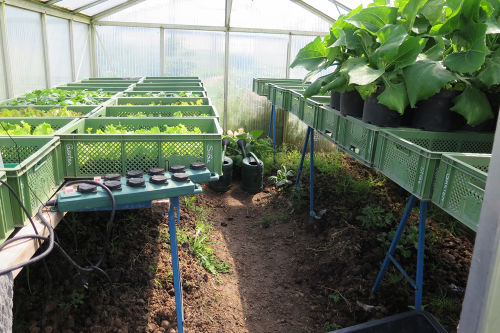CO2 Enrichment: Difference between revisions
m (→External links: + link) |
(Added some more links under the "See Also" section) |
||
| (5 intermediate revisions by 2 users not shown) | |||
| Line 1: | Line 1: | ||
[[File:Horse manure greenhouse.jpg|thumb|right|500px|Horse manure used for CO2 enrichment in a greenhouse. Picture taken at [http://www.siebenlinden.de/index.php?id=1&L=2 Ecovillage Sieben Linden, Germany].]] | [[File:Horse manure greenhouse.jpg|thumb|right|500px|Horse manure used for CO2 enrichment in a greenhouse. Picture taken at [http://www.siebenlinden.de/index.php?id=1&L=2 Ecovillage Sieben Linden, Germany].]] | ||
While the average ambient CO2 concentration in the atmosphere is now (2016) about 400 ppm, | =Basics= | ||
While the average ambient CO2 concentration in the atmosphere is now (2016) about 400 ppm, it can be increased to much higher levels in a greenhouse to improve plant growth. | |||
The rate of CO2 consumption varies with the type of crop, light intensity, temperature, stage of development and nutrient availability. The beneficial effects on plant growth can therefore only be described in broad terms. Some reports claim a doubling or tripling of photosynthesis under certain conditions. Concentrations of 1000-1200 ppm or even up to 1500ppm are used in commercial [[greenhouse]] operations. Above this level, dangerous toxic effects to the crops and workers are more likely to occur. Other potential advantages are lower water use due to changes in plant transpiration with lower water losses. Various CO2 sources are available, such as [[biogas]] or compost which provide very clean CO2. Some [[pyrolysis]] methods (for [[biochar]] production) are also very clean and could be considered as well. However, if combustion products are present, they may be harmful to plant growth. A [[biofilter|soil biofilter]] is a potential solution and could get rid of these contaminants. | |||
=Open Source Hardware Needs= | |||
*CO2 sensors | *CO2 sensors | ||
*pipes, fans | *pipes, fans | ||
==External links | =See Also= | ||
*[[Open Source Agricultural Carbon Dioxide Generator]] | |||
*[[Plant Factory]] | |||
=External links= | |||
* Wikipedia: [https://en.wikipedia.org/wiki/Greenhouse#Greenhouse_carbon_dioxide_enrichment (section in greenhouses page) CO2 enrichment in greenhouses] | * Wikipedia: [https://en.wikipedia.org/wiki/Greenhouse#Greenhouse_carbon_dioxide_enrichment (section in greenhouses page) CO2 enrichment in greenhouses] | ||
* Wikipedia: [https://en.wikipedia.org/wiki/Carbon_dioxide#Agricultural_and_biological_applications (section in CO2 page) Agricultural and biological applications] | * Wikipedia: [https://en.wikipedia.org/wiki/Carbon_dioxide#Agricultural_and_biological_applications (section in CO2 page) Agricultural and biological applications] | ||
* OMAFRA: [http://www.omafra.gov.on.ca/english/crops/facts/00-077.htm "Carbon Dioxide In Greenhouses"] | * excellent from OMAFRA: [http://www.omafra.gov.on.ca/english/crops/facts/00-077.htm "Carbon Dioxide In Greenhouses"] | ||
[[Category:Food and Agriculture]] | [[Category:Food and Agriculture]] | ||
Latest revision as of 23:22, 15 March 2020

Basics
While the average ambient CO2 concentration in the atmosphere is now (2016) about 400 ppm, it can be increased to much higher levels in a greenhouse to improve plant growth.
The rate of CO2 consumption varies with the type of crop, light intensity, temperature, stage of development and nutrient availability. The beneficial effects on plant growth can therefore only be described in broad terms. Some reports claim a doubling or tripling of photosynthesis under certain conditions. Concentrations of 1000-1200 ppm or even up to 1500ppm are used in commercial greenhouse operations. Above this level, dangerous toxic effects to the crops and workers are more likely to occur. Other potential advantages are lower water use due to changes in plant transpiration with lower water losses. Various CO2 sources are available, such as biogas or compost which provide very clean CO2. Some pyrolysis methods (for biochar production) are also very clean and could be considered as well. However, if combustion products are present, they may be harmful to plant growth. A soil biofilter is a potential solution and could get rid of these contaminants.
Open Source Hardware Needs
- CO2 sensors
- pipes, fans
See Also
External links
- Wikipedia: (section in greenhouses page) CO2 enrichment in greenhouses
- Wikipedia: (section in CO2 page) Agricultural and biological applications
- excellent from OMAFRA: "Carbon Dioxide In Greenhouses"